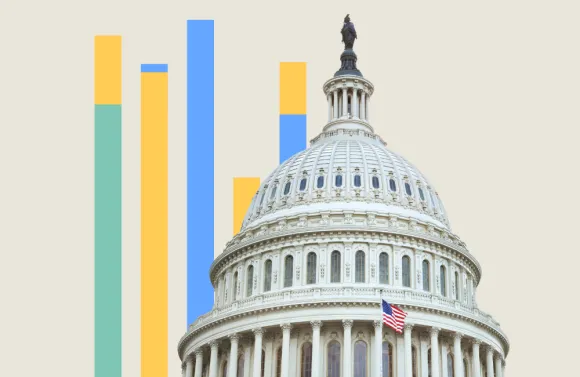
Election Day (November 5) is about a month and a half away. At this point in time, no one can predict who will win the Presidency. I am certainly not about to make a prediction now.
But, irrespective of who wins the White House in November, I can predict what sort of health care policy we could see from the next Administration, irrespective of which political party holds the Presidency.
That is, looking into my crystal ball, I can suggest what health care policy we could see from a Harris-Walz Administration (should there be one), and also, what health care policy we could see from a Trump-Vance Administration (should there be one). Let’s begin…
Harris-Walz Administration
The “Enhanced Premium Subsidies” and ACA Exchange Enrollment: Back in 2021, a Democratic Congress – in coordination with the Biden Administration – temporarily increased the generosity of the premium subsidies for an individual market plan purchased through an ACA Exchange, and also, eliminated the income eligibility requirement for accessing a premium subsidy (referred to as the “enhanced premium subsidies”). In 2022, these enhanced premium subsidies were extended through the end of 2025. There is little doubt that a Harris-Walz Administration is going to do everything they can to extend the enhanced premium subsidies once again. Maintaining the new, record enrollment of over 21 million Exchange plan enrollees (due primarily to the enhanced premium subsidies) will likely be priority #1.
Medicaid Expansion: 10 States have yet to expand Medicaid coverage as called for under the ACA. Expect a Harris-Walz Administration to develop policies to incentivize these so-called “hold out” States to expand Medicaid. A Harris-Walz Administration will also likely require States that have already expanded Medicaid to make Medicaid coverage available to additional populations, and even help States add a “Medicaid buy-in program” for certain uninsured populations.
Prescription Drug Negotiations and Limits on Drug Spending: On the Democrats’ watch, the Medicare prescription drug price negotiations came into the law through the enactment of the Inflation Reduction Act in 2022. Along with this came the $35 statutory cap placed on out-of-pocket costs for Medicare beneficiaries for insulin and the requirement that Medicare’s prescription drug prices cannot increase more than the increase in inflation in a particular year. Expect a Harris-Walz Administration to continue to implement these new legal requirements, and even seek to expand the U.S. Department of Health and Human Services’ negotiating power. Although Congress will need to get involved, expect a Harris-Walz Administration to undertake efforts to extend these limits on drug spending to private-sector health plans.
Mental Health and Substance Use Disorder Benefits: The Biden Administration made it a priority to expand access to mental health and substance use disorder (MH/SUD) benefits through the release of final regulations requiring insurance carriers and self-insured plans to comply with mathematical tests and various definitions, all used to determine compliance with the Mental Health Parity law. Expect a Harris-Walz Administration to vigorously implement and enforce these new regulations. And, expect a Harris-Walz Administration to continue to expand access to MH/SUD benefits through additional network adequacy requirements and establishing a floor for reimbursement rates for MH/SUD providers.
Family Paid Leave: While not necessarily a health policy matter, adding a National Family Paid Leave Program to the law has been a long-term policy priority for Democrats. Governor Walz – as Governor of Minnesota – successfully added a State-wide Family Paid Leave Program in 2023 (effective in 2026). Based on Governor Walz’s experience – and interest in the issue – expect a Harris-Walz Administration to develop policies that would expand FMLA and create family-oriented spending programs through our nation’s public program offerings, led by Governor Walz and his Vice Presidential Team.
Trump-Vance Administration
No “Repeal and Replace,” But Alternatives to the ACA: Although you might sometimes hear it on the campaign trail, Republicans generally have abandoned the “Repeal and Replace” mantra. Instead, Republicans are supportive of making additional health plan options available as alternatives to the ACA. Here, expect a Trump-Vance Administration to champion Association Health Plans (AHPs), which would allow small businesses and self-employed individuals to aggregate together and offer the same type of health coverage large employers offer their employees. Improvements would be made to Individual Coverage Health Reimbursement Arrangements (ICHRAs) to increase take-up, and a Trump-Vance Administration would likely seek to create catastrophic-type health plans that comply with some of the ACA’s requirements, but not all of them.
Expand HSAs, Direct Primary Care and Telehealth: Related to developing alternatives to the ACA, expect a Trump-Vance Administration to make it easier for employers to pay first-dollar for Direct Primary Care and Telehealth services without rendering an HDHP-plan holder ineligible to contribute to their HSA for the year. I wouldn’t be surprised to see this same HSA-friendly policy extended to paying first-dollar coverage for more chronic disease medical items and services, and even cost-containment programs and certain prescription drugs. Efforts could also be undertaken to allow employees to enroll in Direct Primary Care and Telehealth stand-alone health plans.
Price Transparency: Although increasing price transparency is grounded in the ACA, it was the Trump Administration (2016 - 2020) that developed regulations requiring hospitals and health care payers to publicly disclose medical prices on a public website for all to see. While the current state of price transparency is still a bit murky due to non-compliance with the Hospital Transparency Rule and insurance carriers unwilling or unable to disclose “usable” data on the required machine-readable files (MRFs), expect a Trump-Vance Administration to double-down on price transparency, increasing penalties for non-compliance and auditing insurance carriers to make sure their pricing data can be easily “consumed” by employers, plan service providers and researchers. Also expect improvements to the MRFs and required, specified methodologies for determining – and then disclosing – a particular price for a particular medical item or service.
Health Claims Data-Sharing: Although Congress tried to require owners of the provider networks to share health claims data with a health plan sponsor (through the enactment of the Gag Clause Prohibition at the end of 2020), owners of the provider networks are still refusing to share the data. Expect a Trump-Vance Administration to clarify how the Gag Clause Prohibition was originally intended to work, and even force provider network owners to share the claims data or face penalties or co-fiduciary liability.
Medicaid Reform: A Trump-Vance Administration would likely seek to reform the way Medicaid spends its money by establishing block grants that would be awarded to States and per-capita limits placed on how much a State’s Medicaid Program can spend on a particular person in a particular year.
The information provided does not, and is not intended to, constitute legal advice; instead, all information and content herein is provided for general informational purposes only and may not constitute the most up-to-date legal or other information. This summary is provided by a consultant to Benefitfocus.com, Inc., and any opinions expressed within do not necessarily reflect those of Benefitfocus.com, Inc. or its affiliates and are not intended to provide specific advice or recommendations for any plan or individual.


